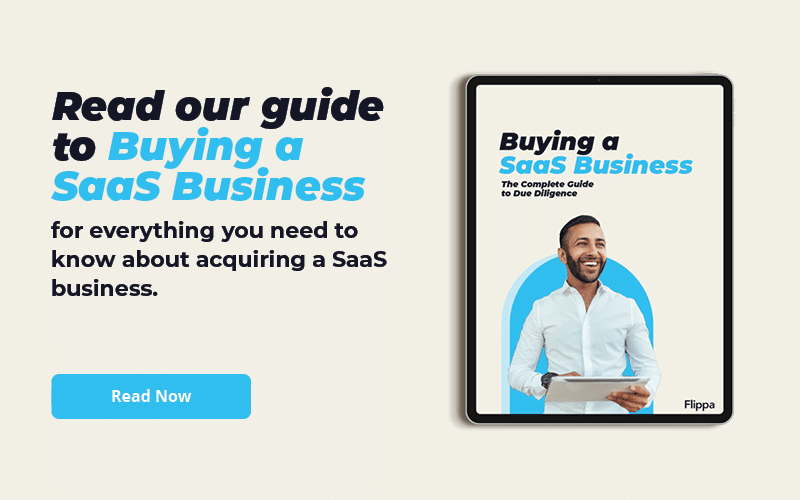
What Does SaaS Stand For?
Software as a Service, or SaaS as it is commonly known, is cloud-based software that has now become mainstream.
From small businesses to large corporations, SaaS is the default deployment method for virtually all types of business technology currently available right now.
Its growing popularity is mainly due to the fact that flexible business applications are delivered via a web browser which means no painful installations. And, since services are paid for over a period of time as opposed to all at once, they are a lot more affordable for businesses.
If you would like to know more about SaaS and how it can be helpful for your company, then read the rest of this article.
In it, we’re going to look at what a software-as-a-service company is and how it works. We’ll also look at the advantages and risks of such companies, as well as 10 examples of some of the most popular SaaS companies around.
What is SaaS?
Software-as-a-service is a model for distributing software where cloud providers create, manage, and host applications to make them available online to end-users as a service.
SaaS is one of the three main categories of cloud computing, alongside:
- Platform as a Service (PaaS): These are cloud computing services that offer hardware, software, and infrastructure required for running and managing applications.
- Infrastructure as a Service (IaaS): These are online services that offer computing, storage, and networking resources on demand.
A software as a service company hosts the application and all related data on its own servers, databases, or networking and computing resources. Alternatively, an ISP can contract the cloud provider to host the software on the provider’s data center.
In this model, third-party cloud providers can be contracted by independent software vendors (ISVs) to host the application. With larger companies, such as Apple or Microsoft, the cloud provider could also be the software vendor.
Who is SaaS For?
SaaS applications can be used by business users, IT professionals, and personal users. There is a wide range of products, ranging from personal entertainment software like Netflix to advanced IT tools like Scalefusion.
Unlike PaaS and IaaS, SaaS products are generally marketed to B2C as well as B2B users. The SaaS industry is currently estimated to be worth US$123 billion and, according to Statista, the market size for global public cloud application services will reach US$145 billion by the year 2022.
How Does SaaS Work?
The way the SaaS business model works is pretty simple. The software vendor hosts and maintains the software or code that makes up the SaaS application, as well as the servers and databases that allow users to access the application over the internet – most likely through web browsers.or directly on websites, for example those like Ahrefs or SEMrush which uses a SERP API for data mining.
Users pay a subscription fee, usually monthly, and they can access the SaaS application at any time, from virtually any device with a web browser and internet connection.
SaaS software subscriptions can be based on a variety of factors, such as:
- The amount of data that needs to be stored
- Information design and options for exporting your data
- How many users will have access to the application
- The level of technical support required
… and so on.
In this web-based model, which is extremely common now, providers give customers access to the same copy of the application created for SaaS distribution. This means that the source code for the application is the same for every customer. When new features are released, they’re instantly rolled out to everyone at the same time.
While subscriptions can be a fixed cost for a business, some SaaS platforms will bill customers according to usage and may become a variable expense.
What are the Advantages of Saas?
One of the biggest advantages of this software is that instead of having to install and maintain software, you can simply access it over the internet. Whether you’re looking to build or buy a SaaS product, there are many advantages to the business model.
In essence, the software sits on the SaaS company’s server and users can access it remotely. This frees you from complex software installations, hardware management, and strict contracts.
Here are a few other benefits of SaaS:
- No need to manually install and run applications on business computers
- No expense for hardware purchases, provisioning, and maintenance
- Eliminates the need for software licensing, installation, and support
- Offers round-the-clock accessibility regardless of the operating system used
- Provides automatic upgrades without adversely affecting business operations
- SaaS is scalable and flexible as you only pay for the features you need
- Easily capture data for analytics through visualization, intelligence, and reporting tools
- Eliminates the need to install and operate the software on computers which gives businesses access to enterprise-level software
- The company can continue to tweak the platform to boost conversions
Of course, with benefits come the risks.
Risks of SaaS
Although this is a ready-made solution that requires no setup or maintenance, it does come with a few drawbacks.
For instance, SaaS poses a few potential challenges and risks since businesses are completely reliant on outside vendors to not only provide the software but also keep it running smoothly, track and report accurate billing, and ensure a safe environment for their data.
Other risks include the following:
- Although most SaaS companies have flexible systems, upgrading capacity could come with a steep price increase.
- Data security is entrusted to a third party and some SaaS companies are not transparent about security standards.
- In case of an unreliable third party, the SaaS company could experience downtime which could adversely affect your business.
- If the SaaS company goes out of business, businesses could be cut off from accessing the service and/or their data.
Furthermore, other issues could arise that are equally beyond the customer’s control such as the vendor experiencing a security breach or imposing unwanted changes to their service offerings.
Fortunately, the best SaaS companies have systems in place to mitigate most, if not all of the risks outlined above.
Examples of SaaS Companies
SaaS companies can handle virtually every business function and it is extremely important to pay attention to trends in the industry and follow possible competitors . Below are 10 examples of popular SaaS companies in different categories that represent the areas where you can implement SaaS tools in your business.
1. Slack
Type of SaaS: Team Collaboration
Putting systems in place to ensure efficient team collaboration is crucial for any business. This is especially true in today’s environment where so many businesses are managing teams remotely. With a SaaS tool like Slack, your teams can collaborate easier and more efficiently, leading to improved productivity.
2. Hubspot CRM
Type of SaaS: Customer Resource Management (CRM)
SaaS CRM is cloud-based software that gives users access to CRM functionality and support. With Hubspot’s CRM, there’s no need to install or maintain anything. SaaS customers can easily manage their customer information and track sales through their pipeline. This type of CRM helps businesses personalize and automate sales, customer service, and overall digital strategy.
3. Shopify
Type of SaaS: Web hosting and eCommerce
Currently, there are over 1 billion websites in the World. Building a website has become extremely easy thanks to powerful SaaS website building tools like Shopify that take away the need for complex manual coding. With this cloud-based site-building platform, you can easily create a website, edit, and manage it from any location with ease.
4. Oracle
Type of SaaS: Enterprise Resource Planning (ERP)
SaaS ERP is a system of multiple SaaS applications most ideally suited for large organizations. It’s a system that runs in the ERP vendor’s data center, instead of the purchasing organization’s infrastructure and servers (known as on-premises ERP) so that end-users can access the software online.
5. Apache Spark
Type of SaaS: Data pipeline service
Apache Spark, another popular SaaS company, provides software for helping enterprise clients transfer their data. It’s an analytics engine designed specifically for large-scale data processing. This data pipeline tool performs processing tasks on huge sets of data before distributing it across various sources.
6. Zoho Projects
Type of SaaS: Project Management
Zoho Projects offers a low-cost project management app that has a wide range of helpful features. It’s an appealing option, particularly for small and growing businesses with a tight budget. This type of software can help collaborators communicate easily and stay on track in an effective and cost-efficient way.
7. Nextiva
Type of SaaS: Customer Support
Customers are the lifeline of any business, and it’s crucial to keep them satisfied so they return to make more purchases. An app like Nextiva can help you create a great impression with your customer support. It comes with a ton of other features, including sales tools, automation tools, and intelligence tools.
8. Ezoic
Type of SaaS: Display ad technology
Ezoic is an interesting platform as it’s built specifically to be a viable alternative to Google Adsense. While Adsense allows publishers to show ads on their website with little effort, Ezoic takes that a step further by using AI to help publishers maximize their ad earnings without negatively impacting the user experience. It integrates with multiple ad networks such as Adsense and Media.net to show the highest bidding ads across networks, thus increasing earnings for the site owner.
9. InVideo
Type of SaaS: Online Video Editor
InVideo is a fan I’m personally a fan of and use often. It’s an online tool aimed towards making video editing more comprehensible and accessible to the masses. With the rising popularity of videos on social media and marketing spaces, this tool helps users to cut down the fuss around video creation. With more than 5000 hand-crafted templates InVideo is used across 190+ countries to make and edit various kinds of videos.
10. HootSuite
Type of SaaS: Social Media Management
Social media plays a huge role in the success of any business these days. A tool like HootSuite will allow you to track and manage your social network channels, monitor feedback about your business or product, and instantly respond to comments – all from one place.
Interested in getting into the SaaS business? Search for SaaS businesses for sale on Flippa.

Want to learn more about Buying a SaaS Business before acquiring one? Read our Guide to Buying a SaaS Business to find out everything you need to know

Recommended for you
Discover more from Flippa
Subscribe to our Blog
Get the latest blog posts, insight reports and news directly to your inbox every week.



















